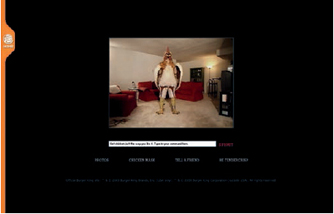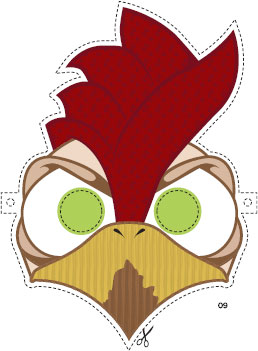Burger King
Subservient Chicken
Crispin Porter + Bogusky
Burger King’s Subservient Chicken website was launched in 2004, and immediately caused an internet storm, receiving millions of hits in a matter of days. Its impact on the advertising industry as a whole was equally seismic – prior to Subservient Chicken, agencies and brands had been tiptoeing around using the internet, uncertain of how it could be useful to them, and viewing it more as a threat than an opportunity. Subservient Chicken showed that brands could use the web to be playful, to be risqué, and, most of all, to interact with their audiences.
‘It was a cool idea, and we took it way too far, and that’s why it worked.’
Initially, the campaign had been all about TV. Burger King had wanted to bring back the tagline ‘have it your way’ in its marketing, so when working on a brief for the TenderCrisp chicken sandwich, U.S. ad agency Crispin Porter + Bogusky came up with the concept of a giant chicken-man being instructed to perform various tasks at the whim of its owners. A set of television ads were created, all with a cheeky tone reminiscent of the website, although these have now been largely forgotten. ‘We actually shot the spots and they ran,’ says Jeff Benjamin, partner/chief creative officer at CP+B, ‘but now nobody really remembers them, they just remember the website. I think this is a great example of how you can have a great idea, but you also have to find the right medium for that idea.’
The website was a last-minute add-on to the campaign, but gave the opportunity of taking the TV idea to a much higher level, and of inviting the audience to join in. The concept was simple – place the giant BK chicken from the ads in a room with a webcam, and allow visitors to the site to type in a command, which the chicken would then act out. The chicken would appear to be reacting live to the commands, but in fact the site was pre-programmed to respond to hundreds of instructions. ‘Originally it was going to be more of a PR thing,’ says Benjamin, ‘where for one day people could tell the chicken what to do. But we had recently stumbled on some technology for a campaign for another client, where we did a banner where you could just put in a sentence and it would pick up keywords and then trigger an animation. So with that fresh in mind, and looking at the TV campaign, it brought about the idea for the website.
‘We wrote up the idea on a Word doc,’ Benjamin continues, ‘and I remember going over to the client’s house and pitching it to her, and they bought it. It was one of those ideas where we thought, “Oh my God, we sold it!” We were a little scared, because when we’d tried something similar with the technology, it was on a much smaller scale. We were freaked out, and there were days when we wanted to go back to just doing it for one day… but every time we thought, “no, we’ve got to do this!” At that point we connected with the Barbarian Group; they started helping us with the technology and how to do it, and that gave us more confidence in the idea.’
01 The Subservient Chicken warms up in the apartment where the website footage was shot.



2-07 Stills from the Burger King Subservient Chicken website, showing the chicken performing various different commands submitted by visitors online.
08 Promotional materials for the Subservient Chicken campaign.
‘It just exploded instantly. It travelled like a piece of news, and the news was that a big brand that we’ve never heard a peep from before had made this really weird thing.’
Rather than feature just a few simple commands, the creative team wanted it to be rigorous, to make it impossible for users to crack. So they turned to the whole agency for help. ‘We made a fake website, just for the agency internally,’ says Benjamin. ‘I Photoshopped a picture of one of the creative directors and put it on a guy in the chicken suit, and there was a form field at the bottom where we said, “if this website were real, and you could ask the chicken to do anything, what would you ask it?” We had 200 people at that point and we collected all the actions people were asking the chicken to do. We got thousands and thousands. Then we went through them and from those thousands we gleaned a couple of hundred unique actions, because people would ask the same things over and over again. So we started with our list of those couple of hundred and then added a day to the TV shoot. We set up in one of the camera guys’ apartments and just shot the chicken for the whole day. At the end of the day we had about 500 actions.’
‘It was a cool idea, and we took it way too far, and that’s why it worked,’ says Benjamin Palmer, co-founder and CEO at the Barbarian Group. ‘We could have just shot a few videos, but we shot hundreds and hundreds of clips. We did everything in a day on the shoot, and the code to do the artificial intelligence stuff was maybe a couple of days’ programming. There’s not really a lot of technology in there, but we did spend a month and a half writing 25,000 different keywords into the database, in three different languages, with all sorts of slang, and then beta-tested it. No matter who was using it, it was magic; you would just say, “how did it know that?” You played with it saying, “I’m going to stump this thing,” and then you totally couldn’t.’
The range of commands that the chicken responds to is phenomenal, from simple suggestions such as ‘swim’ or ‘sit’ to more obscure instructions including ‘riverdance’, ‘walk like an Egyptian’, or ‘do the YMCA’. The look of the website is deliberately lo-fi, almost dingy, but despite its seedy surroundings, the chicken is surprisingly moral, responding with a scolding finger to the camera if the instructions become too explicit. The chicken also knows which brand it is marketing – if a user suggests that it eats a McDonald’s, it places a finger down its throat. Unsurprisingly, a lot of fun was had on the shoot: ‘Another funny thing is that originally the website was going to have sound, but we were laughing so loud in the background, we had to take it out,’ says Jeff Benjamin. ‘But it’s probably better without sound.’

09 A cut-out-and-keep Subservient Chicken mask, used to help promote the TV campaign and the website.
‘It was a pain in the ass because everybody in every meeting after that would say, “give me a chicken”. We got calls for three years straight about that. But at the same time it helped everyone who wanted to do something new.’
The release of the site was fairly loose. ‘We just posted it on some of our blogs…,’ says Benjamin Palmer. ‘It was early days, so Boing Boing picked it up, people picked it up organically from us. We sent out some links and we had 100,000 visitors in a day, which was completely insane. Then it just exploded instantly. It travelled like a piece of news, and the news was that a big brand that we’ve never heard a peep from before had made this really weird thing.’
Subservient Chicken is very much of its time, and was successful in part because no one had done anything like it for a brand before. It was one of the first online ad campaigns to go truly viral, and it demonstrated that, if the idea is appealing enough, people will interact with brands online and tell all their friends about them too. ‘It legitimized our approach,’ says Palmer. ‘We had done other stuff, and tried to pitch things that were pushing clients a lot further than they felt comfortable going, and we hadn’t had a huge success yet, so that legitimized that approach. The chicken was pure branding; it didn’t really tell you anything about the product. It was the internet version of a big fancy TV branding ad, and nobody had ever done that. It was a pain in the ass because everybody in every meeting after that would say, “give me a chicken”. We got calls for three years straight about that. But at the same time it helped everyone who wanted to do something new.’

10-12 Photographs of the Subservient Chicken taken during the shoot for the Burger King television campaign and website. The campaign became famous as a website, though it originally began as an idea for TV, and a series of commercials were made featuring characters ordering the chicken to perform certain tasks. These ads have been largely forgotten now though, while the website continues to be popular years after it was first released.
‘Another funny thing is that originally the website was going to have sound, but we were laughing so loud in the background, we had to take it out.’





